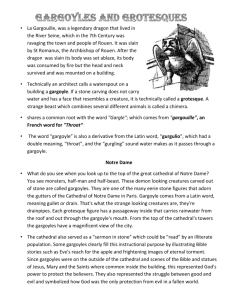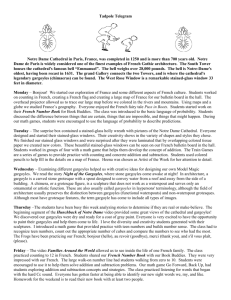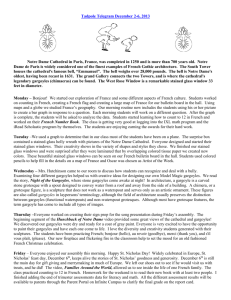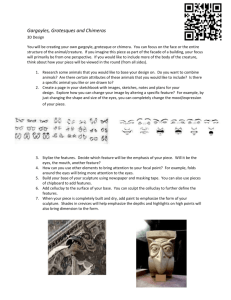Gargoyles - WordPress.com
advertisement
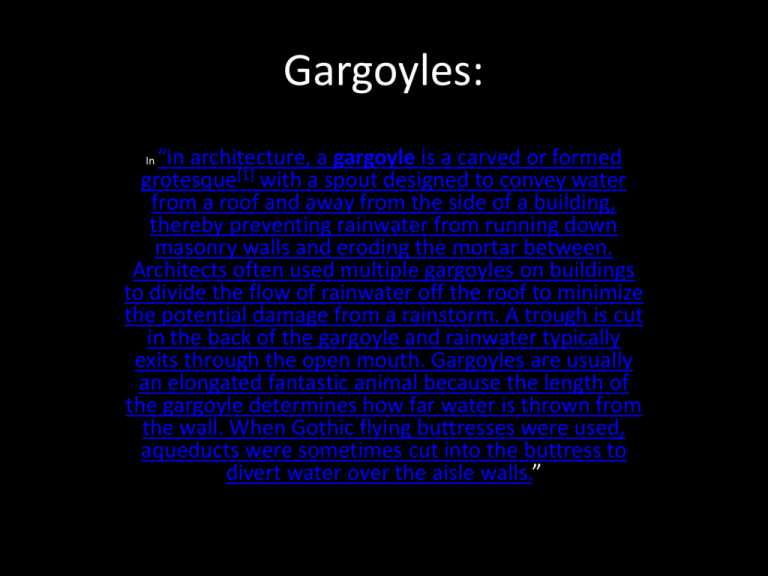
Gargoyles: “in architecture, a gargoyle is a carved or formed grotesque[1] with a spout designed to convey water from a roof and away from the side of a building, thereby preventing rainwater from running down masonry walls and eroding the mortar between. Architects often used multiple gargoyles on buildings to divide the flow of rainwater off the roof to minimize the potential damage from a rainstorm. A trough is cut in the back of the gargoyle and rainwater typically exits through the open mouth. Gargoyles are usually an elongated fantastic animal because the length of the gargoyle determines how far water is thrown from the wall. When Gothic flying buttresses were used, aqueducts were sometimes cut into the buttress to divert water over the aisle walls.” In • The term originates from the French gargouille, which in English is likely to mean "throat" or is otherwise known as the "gullet";[2] cf. Latin gurgulio, gula, gargula ("gullet" or "throat") and similar words derived from the root gar, "to swallow", which represented the gurgling sound of water (e.g., Portuguese garganta, "throat"; gárgola, "gargoyle"). It is also connected to the French verb gargariser, which means "to gargle."[3] The Italian word for gargoyle is doccione or gronda sporgente, an architecturally precise phrase which means "protruding gutter." • When not constructed as a waterspout and only serving an ornamental or artistic function, the correct term for such a sculpture is a chimera, or boss. Just as with bosses and chimeras, gargoyles are said to frighten off and protect those that it guards, such as a church, from any evil or harmful spirits. • Gargoyles were viewed in two ways by the church throughout history. The primary use was to convey the concept of evil through the form of the gargoyle, which was especially useful in sending a stark message to the common people, most of whom were illiterate. Gargoyles also are said to scare evil spirits away from the church, this reassured congregants that evil was kept outside of the church’s walls.[9] However, some medieval clergy viewed gargoyles as a form of idolatry. Animal gargoyles • The ancient Egyptians, Greeks, Etruscans and Romans all used animal-shaped waterspouts.[12] During the 12th century, when gargoyles appeared in Europe, the Roman Catholic Church was growing stronger and converting many new people. Most of the population at this time were illiterate, and therefore images were very important to convey ideas. In the medieval world many creatures had mystical powers attributed to them. Also, human qualities were sometimes ascribed to specific animals—that is, the animals were anthropomorphized. This was especially common for pagans, and using these ideas helped conversion to Catholicism. Some animals (such as the rhinoceros and the hippopotamus) were unknown in western Europe during the Middle Ages so gargoyles of these species (such as the ones at Laon Cathedral) are modern gargoyles and therefore did not have symbolic meaning in Medieval times.[13] Your next assignment is to create a gargoyle that will hang from the wall. • 1. This means you have to figure out how to make it hang, where the weight will be, and how it will balance. • 2. Rough drawing is required and you must follow it and hand it in at the end of the assignment with your gargoyle. It cannot be larger than 8 inches in any direction or points will be taken off and It can not be smaller than 8 inches in at least one direction. • 3. It must be created using any or all of the techniques you have learned so far which is coil, pinch or slab. • 4. It must show texture. • 5. It must be original and not a favorite cartoon character. • 6. It must have a mouth that is open and can act like a spout of a real original gargoyle. • 7. It must be a creature of sorts either half human or some kind of animal. • 8 It must be neatly executed without cracks or un joined seams. References: • • • • • • • • • • • http://en.wikipedia.org/wiki/Gargoyle http://2.bp.blogspot.com/-nMSyparDvs8/UjClxMqxvcI/AAAAAAAABf4/5oXcmtGqthM/s1600/g-3.gif http://www.thehorrordome.com/images/products/detail/6098LG.jpghttp://4.bp.blogspot.com/_nV nVVChb654/S8dapu-cG3I/AAAAAAAAAJM/rDkDqA81f5U/s1600/IMG_6639.JPG http://www.allfranceinfo.com/images/cathedrals/notre-dame-gargoyles.jpg http://activerain.trulia.com/image_store/uploads/9/2/2/8/5/ar130453200358229.JPG http://www.utaot.com/wp-content/uploads/2012/12/gargoyle-gargoile-demon-notre-dameparis.jpg http://upload.wikimedia.org/wikipedia/commons/c/c9/Paisley_Abbey_gargoyle_13.jpg http://i.huffpost.com/gen/1792952/thumbs/o-GARGOYLE-900.jpg?6 https://storki.files.wordpress.com/2014/09/europe-2014-6080-edit-2-1.jpg http://us.123rf.com/400wm/400/400/ewanchesser/ewanchesser0810/ewanchesser081000116/37 14568-the-gargoyles-of-notre-dame-cathedral-paris.jpg http://pad3.whstatic.com/images/thumb/9/94/Gargoyles!-(Dornoch-Cathedral).jpg/259pxGargoyles!-(Dornoch-Cathedral).jpg

